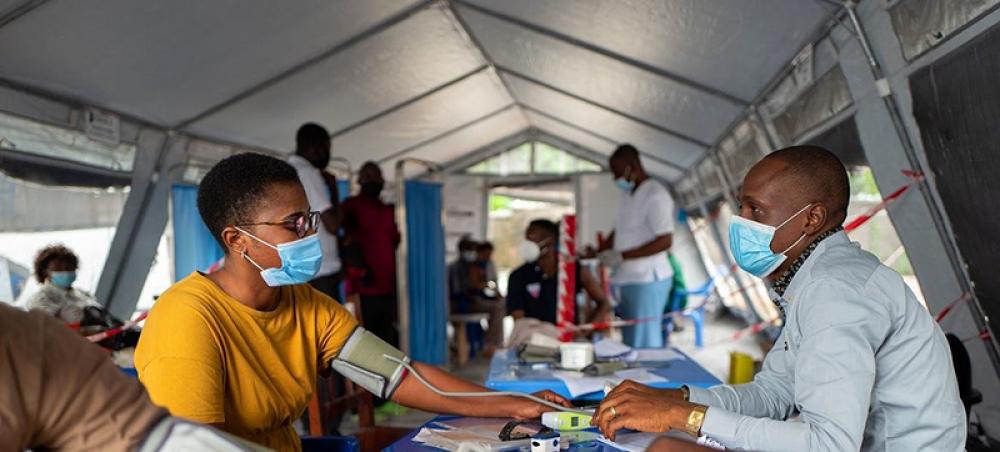Just Earth News | @justearthnews | 18 Mar 2023, 07:42 am Print

Image: UNICEF/Gwenn Dubourthoumieu
New York: The World Health Organization (WHO) continues to call for China to be ‘transparent’ in sharing COVID-19 data in efforts to determine the disease’s origins, Director-General Tedros Adhanom Ghebreyesus reiterated on Friday in Geneva.
Speaking during his latest media briefing, Tedros noted that the world is in a much better position now that at any time in the pandemic, which just entered its fourth year.
For the first time, the weekly number of reported deaths in the past four weeks has been lower than when the pandemic was first declared.
“I am confident that this year we will be able to say that COVID-19 is over as a public health emergency of international concern,” he said.
Origins a mystery
“Even as we become increasingly hopeful about the end of the pandemic, the question of how it began remains unanswered,” he added.
Last Sunday, the Chinese Center for Disease Control and Prevention uploaded data to the global virus database, GISAID, related to samples taken at the Huanan market in January 2020.
The seafood market is located in Wuhan, the city where SARS-CoV-2, the virus that causes COVID-19, first emerged.
Scientists from several countries downloaded and analyzed the data, which was later removed. They have reportedly found molecular evidence that animals were sold at the market, some which, including raccoon dogs, were susceptible to SARS-CoV-2 infection.
No definitive answer
Tedros said WHO contacted the Chinese CDC and urged them to share the data with the UN agency and the international scientific community.
WHO convened its Scientific Advisory Group for the Origins of Novel Pathogens (SAGO) on Tuesday. Researchers from the Chinese CDC and international scientists were asked to present their analyses.
“These data do not provide a definitive answer to the question of how the pandemic began, but every piece of data is important in moving us closer to that answer,” said Tedros.
He stressed that all data relating to studying the origins of COVID-19 needs to be shared with the international community immediately.
Appeal to China
“These data could have – and should have – been shared three years ago,” he said.
“We continue to call on China to be transparent in sharing data, and to conduct the necessary investigations and share the results. Understanding how the pandemic began remains both a moral and scientific imperative,” he added.
Dr. Maria Van Kerkhove, WHO lead on COVID-19, said the agency was already aware of environmental samples from the market that had tested positive, and the latest results offer “a deeper dive” into the information.
“What this does is provides clues…to help us understand what may have happened,” she said. "One of the big pieces of information that we do not have at the present time (is) the source of where these animals came from.”
She said WHO has repeatedly asked for studies to be done at other markets in Wuhan and across China, and to trace animals back to their source farms, as well as serology to be conducted on people who worked at the markets or on farms.
Research continues
Meanwhile, WHO continues to work with international partners to better understand how the pandemic began.
Dr. Van Kerkhove underlined the importance of data sharing so that international experts can conduct open and transparent analysis, as well as discussion and debate.
“Right now, there are several hypotheses that need to be examined, including how the virus entered the human population: either from a bat, through an intermediate host, or through the release, a breach in biosafety or biosecurity, from a lab. And we don't have a definitive answer of how the pandemic began,” she said.
Dr. Michael Ryan, Executive Director of WHO’s Emergencies Programmes, used the analogy of solving a jigsaw puzzle to explain the complexity of COVID-19 research and the need to have access to all available data.
“This is another piece of the jigsaw. It’s an important piece, but it does not determine what the picture shows," he said. "But what it does do is allow science to do its work."
Dr. Van Kherkove was also asked why China removed the data from the virus platform, but she said that question should really be addressed to the country’s CDC.
“What we understand is that this data was submitted by China CDC as part of their work in writing a publication; a publication that was submitted last year and put up as a pre-print. That pre-print is available,” she said.
“Our understanding is that that paper has been updated and re-submitted. And in the re-submission, China CDC put more data available on GISAID.”
- From thinning to thriving? New hair loss treatment is showing promising results in trials
- Surprising coffee link: Daily cups may slow ageing in severe mental illness
- Malaria crisis looms as WHO reveals explosive rise in drug resistance
- Study shows nanoplastics from bottles are not just pollution—They may be harming you from within
- Are birth control pills affecting your mental health? New study raises red flags



-1763561110.jpg)


